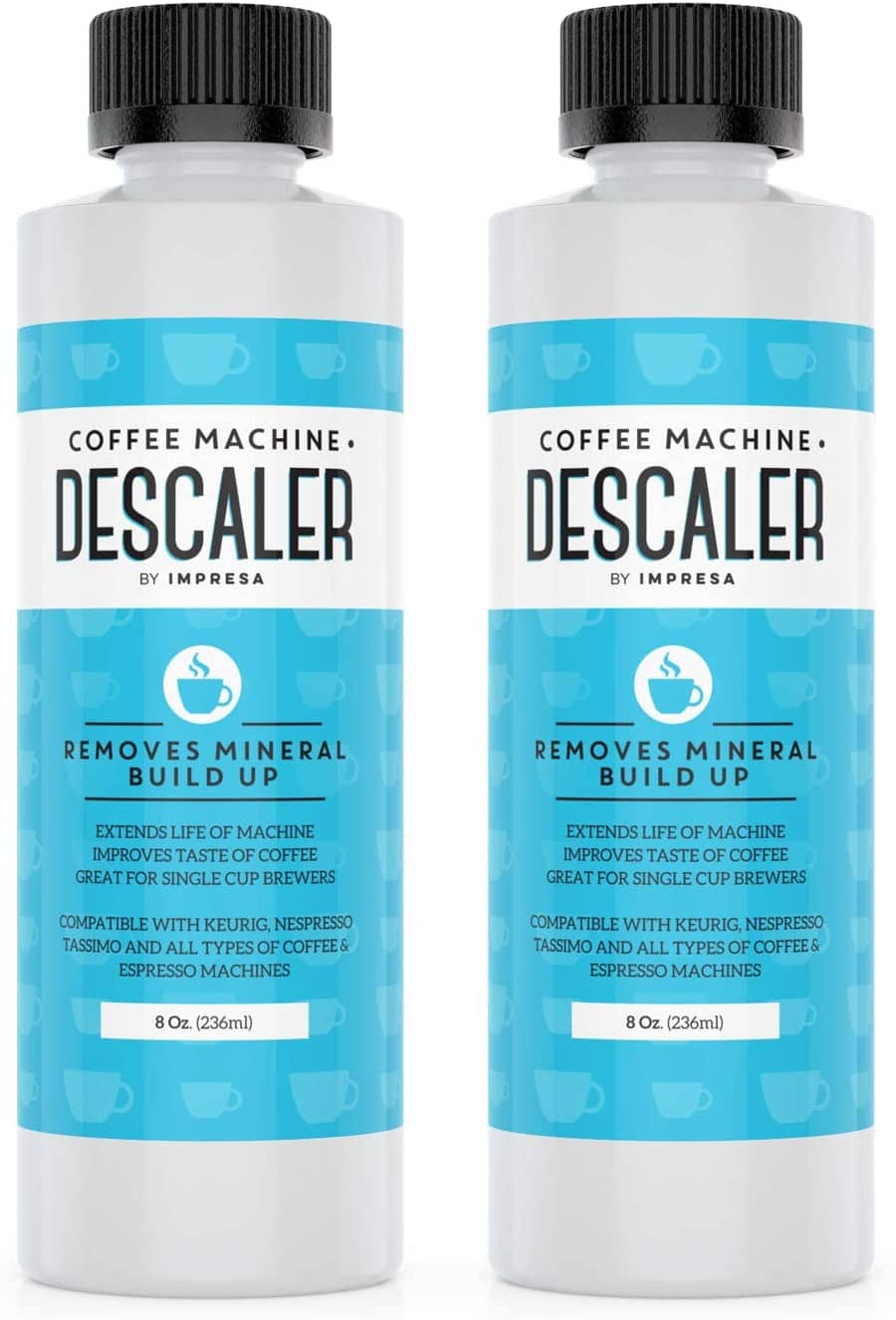
If you’re a Nespresso owner you want your machine to work correctly every time. But! if you don't clean or “descale” your Nespresso, mineral deposits and other grime can build up and damage the expensive machine. So how often should you descale your Nespresso to keep it pumping out that oh so delicious espresso.
Nespresso suggests that as a general rule you descale your Nespresso machine after every 600 capsules. The frequency of descaling can vary based on how hard the water is. At a minimum, plan to descale your Nespresso machine once every six months to keep mineral deposits and grime from building up inside of it.
In the rest of this article we'll dive into the specifics of descaling your Nespresso machine so that you can make sure you avoid any damage while also not wasting time with unessesary cleaning.
Related: Is it Safe to Drink from Nespresso After Descaling?
What is Descaling a Nespresso Machine? (And Why You Should Descale)
Descaling the Nespresso machine is a critical part of making sure this appliance lasts as long as possible and gives you a consistently great cup of coffee/shot of espresso every time you use it. In short, descaling is the process of reducing or removing mineral deposits like calcium and magnesium that slowly build up over time inside your Nespresso because of the mineral content in your water.
Why should you descale your Nespresso machine, you ask? It’s simple. The mineral buildup can slow down or stop the flow of water, and this can negatively impact how well the machine heats up and works. In worst-case scenarios, it can alter how your coffee tastes. Also, allowing this buildup to happen can potentially cause damage to your Nespresso over time. So, regularly descaling can help it last longer and ensure you get high-quality espresso.
I know my Nespresso machine is overdue for a descale when the water starts to dribble or splutter out instead of coming out in a neat stream. This is also about the time that I get an unpleasant aftertaste with my drink, and no one wants a subpar cup of coffee or espresso, especially from this machine. Once I descale, it’s back to top working condition and my coffee is back to tasting how it should.
Related: Can you Use Keurig Pods in a Nespresso?
How Often to Descale a Nespresso Machine
To figure out how often you should descale your Nespresso you need to understand a few key factors. First, you have to know about water hardness. If your water is hard, it means that it has a high mineral content. Since there are more minerals, limescale and calcium can build up faster, so you should descale your machine more frequently to combat it. On the other end of the spectrum, if you have soft water with lower mineral content, you’ll get less limescale, and you may not need to descale it as often.
The model of your Nespresso is also something to consider. Different models can come with differing descaling schedules. You’ll want to look at your model’s manufacturer guidelines and check the user manual to get the best schedule.
Another thing to consider is how often do you use your machine? If you’re someone who drinks coffee from the Nespresso several times a day, you’ll need to descale it more frequently. But, if you only make a cup of coffee every few days, the grime won’t build up as fast.
Every morning before work it's my ritual to start my day with my Nespresso machine. The ritual, the smell, and the caffeine is almost necessary at this point for me to have great start to my day. Sometimes I even have a second cup after lunch if I'm feeling low on energy, but I generally try to avoid afternoon caffeine since it affects my sleep.
Finally, if you rinse your machine frequently, this can impact how often you descale it. Regularly running a rinsing brew with water can help to combat the coffee residue buildup and minor mineral deposits, and this could make it ok to wait longer between descaling sessions.
Related: Is Espresso Healthy?
How to Descale a Nespresso Machine
Once you've decided when you want to descale your Nespresso now you need to know how to actually do it. Below is a quick and easy process that helps to keep your machine in top condition, ensuring it gives you your coffee when and how you want it. We’ll walk you through step by step below.
Step 1: Prep the Machine
Start by removing any capsules in the machine and emptying the drip tray and the water tank. Turn off and unplug the machine before you start to avoid getting shocked.
Step 2: Clean the Outer Parts of the Machine
Take a clean, damp cloth and gently wipe the outside of your machine. While you do, make sure you get the capsule holder, the drip tray, and the water tank. Also remove any coffee residue or dust you see.
Step 3: Prepare the Descaling Solution
Nespresso recommends using their own descaling solution, which is specially designed for their machines. Mix the descaling solution with water in the water tank according to the instructions provided on the package. If you can't or don't want to buy Nespresso's descaler, there are plenty of other options such as Amazon's best-selling descale solution below.
Click Here to See on Amazon
Some people claim you make your own descaler by adding four cups of water to one cup of distilled white vinegar. However, we really recommend going with Nespresso’s branded descaler as the vinegar can damage your machine, and it may also void any warranty you have on it.
Step 4: Switch on Descaling Mode
Plug in and switch on your Nespresso machine. Depending on your Nespresso model, the way you get it into descaling mode can vary, so take a few minutes and look at your user manual. Generally, you will need to press and hold down one or more of the buttons for a few seconds to switch this mode on.
Step 5: Run the Descaling Cycle
Put a large mug or container under the spout to catch the descaling solution. Once you get your Nespresso machine into the descaling mode, press the brew button to start the descaling cycle. The solution will flow through the machine, removing limescale deposits along the way.
Step 6: Get Rid of the Solution
After the descaling solution has run through the machine, make sure to properly discard the used solution that was collected in the container. It should not be consumed or come into contact with your skin because it can be caustic and cause skin irritation, so handle with care!
Step 7: Rinse Thoroughly
Once the descaling cycle is complete, empty the drip tray and refill the water tank with fresh, clean water. Run a few more cycles, this time with just water, to rinse out any remaining descaling solution. Depending on your Nespresso model, you may need to run several rinse cycles to get rid of any stray descaler.
Step 8: Exit Descaling Mode
Again, depending on your model, you will need to follow specific steps to exit the descaling mode. Usually, it involves holding down one or more buttons for a few seconds.
Step 9: Clean and Reassemble
Give the drip tray and water tank a good wash, then reassemble your Nespresso machine. You're now ready to enjoy a delicious cup of coffee and have your machine running in tip top shape. Remember, regular descaling helps maintain the quality of your coffee and prolongs the life of your machine.
A Brew-tiful Ending

Regular descaling is an important investment to make in the health of your coffee maker. It ensures that your coffee machine works well, makes great-tasting drinks, and will work for many years. So, don't wait; keep your Nespresso machine descaled and ready to serve up your daily dose of liquid sunshine. After all, a well-cared-for machine means a well-brewed cup of coffee. Here's to many more brew-tiful mornings with your Nespresso!
FAQs
1. How do you know when you should descale your Nespresso?
If you’ve just gotten your Nespresso or you’re not sure when is the best time to descale it, there are several clues you can consider. They include:
- Coffee has a burnt taste
- Coffee has an odd aftertaste
- Machine is starting to leak
- Coffee doesn’t come out as hot as it once did
- It’s slow to release the coffee
If you notice any of these issues, make a point to descale your Nespresso machine as soon as you can.
2. How often should you descale your Nespresso machine?
The frequency of descaling depends on factors such as water hardness, how often the machine is used, and the specific model of your Nespresso machine. As a general guideline, Nespresso suggests descaling every 600 capsules or every six months, whichever comes first. However, if you use hard water or use your machine heavily, you might need to descale more frequently.
3. Can you use vinegar to descale your Nespresso machine?
While vinegar is a common household item used for cleaning some appliances, however, it's not recommended for Nespresso machines. Nespresso suggests using their own descaling solution, which is specifically designed to work with their machines without causing damage. Using vinegar may void your warranty and could potentially harm the machine.
4. What if you don't descale your machine?
Failure to descale your machine regularly can lead to limescale buildup which may affect the taste of your coffee, impair the machine's performance, and possibly shorten its lifespan. So, descaling is an essential maintenance task if you want to keep enjoying great-tasting coffee and prolong your machine's life.
5. How long does the descaling process take?
The entire process, from preparation to clean-up, generally takes about 20 to 30 minutes. It's a small investment of time that can greatly enhance your coffee experience and the longevity of your machine.
6. Your machine has an alert for descaling. Does it know when it's time?
Some Nespresso machines have an alert system for descaling, based on a factory setting. While this is a helpful feature, you should also consider your water hardness and machine usage when deciding how often to descale. You can wait until the alert pops up to descale it, but if you use your machine a lot, you may find yourself descaling sooner.
